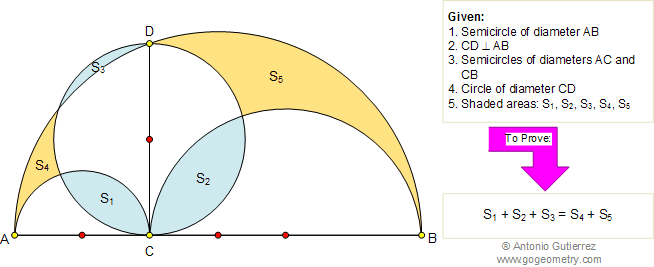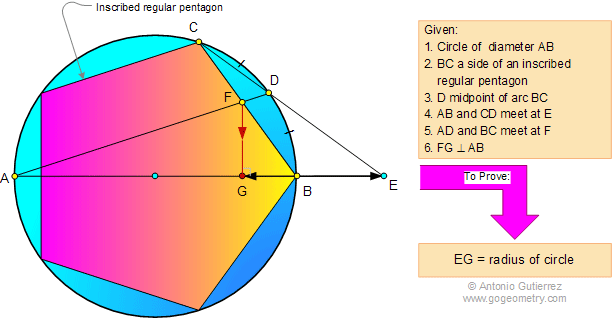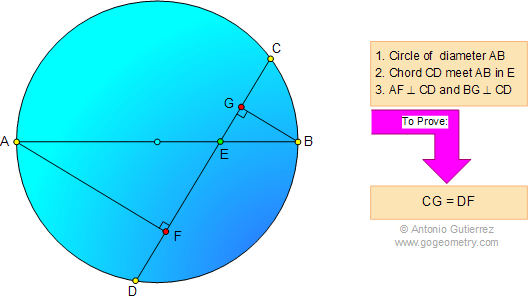Book of Lemmas
The Book of Lemmas (also Book of Lemmas ) is a collection of 15 statements about the geometry of circles. It is attributed to the ancient Greek mathematician Archimedes, whose authorship is questionable.
- 6.1 Digitised
- 6.2 visualizations
History
The Syrian mathematician Thabit ibn Qurra has the manuscript in the 9th century from Greek into Arabic (entitled K. al - Usul al - Ma'hūdāt fī Handasa ) translated and attributed it Archimedes; from the 10th century, a comment by Alī ibn Ahmad al - Nasawī is handed down. In 1661 the text of Abraham Ecchellensis was translated into Latin by Giovanni A. Borelli and as ArchiMedis Liber Assumptorum in his work Apollonii Pergaei Conicorum lib. V, VI, VII issued. The English mathematics historian Thomas L. Heath in turn created an English version of the Liber Assumptorum and took this in 1897 under the title Book of the lemma in his anthology The Works of Archimedes on. This volume was - supplemented inter alia by a contribution from the Danish historian Johan Ludvig Heiberg mathematics methods of Archimedes - 1914 by Fritz Kliem translated into German ( Archimedes ' works ); Chapter Book of the lemma is called the Book of Lemmas here.
The 15 statements are the Liber Assumptorum and called in the Book of Lemmas " propositions " in the German translation Kliems " sets ". In Greek, the work is not known.
Authorship
The authorship of Archimedes ' is not backed up. Doubt excite particular passages of the text, in which Archimedes in the third person reference. In Theorem 4, for example, the speech by a character (meaning the Arbelos ), which is called "a so-called Archimedes Άρβυλος " ( " quam vocat Archimedes Arbelon " or "what Archimedes called to Άρβυλος ").
On the question of authorship Archimedes ' leads from Heath (right next to the translation Kliems ):
"The lemma can not, HOWEVER, have been written by Archimedes in Their present form, Because his name is quoted in them more than once. The probability is thatthey were propositions collected by some Greek writer of a later date for the purpose of elucidating some ancient work, though it is quite likely did some of the propositions were of Archimedean origin, eg respectively Those Concerning the geometrical figures called Άρβυλος ( literally ' shoemaker's knife ') and σαλινον ( probably a ' salt - cellar '), and Prop. 8 Which bears on the problem- of trisecting of angle. "
" However, the auxiliary sets can not be written in the present form of Archimedes, as his name is mentioned several times in it. Probably there were sets that have been collected by a later Greek writers to explain an old work, but it is quite likely that some of the sentences Archimedean origin, such as those that deal with the geometric figures the name Άρβυλος (literally " cobbler 's knife" ) and σαλινον (perhaps " salt cellar ") apply, and theorem 8, which deals with the problem of the trisection of an angle. "
In summary, this means that at least the Arbelos ( the aforementioned " cobbler 's knife" ), the Salinon (the " salt shaker " ) and as set out in Proposition 8 method of trisection of an angle with high probability can be attributed to Archimedes.
Content
The 15 sections of the text contain statements about circles, with their diameters and radii, secants and tangents to and the ratios of these elements to each other, and the associated evidence. They are all illustrated in the Latin version in the English and German version, with the exception of Theorem 7.
As an example, let set 2 are used, quoted and illustrated by Kliem:
" Let AB be the diameter of a semicircle, and the tangents to it at B and any other points D may intersect in T. One falls from D to AB the perpendicular DE, and AT, DE intersect in F, then DF = FE. We extend AD to the intersection points H with the extension of BT. Then, the angle ADB in a semicircle is a right; consequently the angle BDH is a right. TB, TD are the same. Thus, T is the center of the semicircle on BH as the diameter that passes through D; Thus, HT = TB. Since DE and HB are parallel, it follows that DF = FE. "
Arbelos and Salinon
In particular, the two each consisting of several semi-circles geometric figures Arbelos and Salinon be more complex, introduced: The Arbelos even in sentence 4, the twin circles of Archimedes in Theorem 5, the inner circle of the Arbelos ( which in turn is related to the Pappus chain, as Kliem remarks in a footnote ) in Theorem 6, and finally the Salinon in Theorem 14
Twin circles
Pappus chain
Salinon










